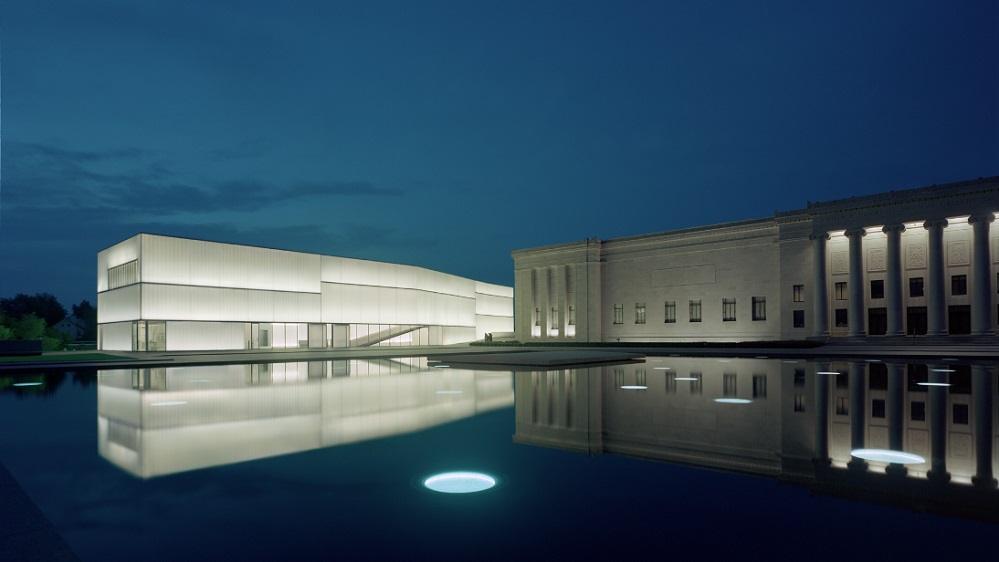VISUAL ARTS
Kansas City Star
JUNE 07, 2017 5:15 PM
BY DAVID FRESE
dfrese@kcstar.com
At a town hall meeting before the Bloch Building opened 10 years ago at the Nelson-Atkins Museum of Art, a man stood up to tell architect Steven Holl and then-director Marc Wilson that the planned addition looked like a Styrofoam cup.
Some critics likened its placement next to the classic 1933 museum structure to a man in a tuxedo wearing brown shoes. Others said the building reminded them of those big white equipment sheds you’d find on the Kansas prairie.
The most famous and thoughtful critique of the Bloch Building came some years later, but it was not directed at the exterior so much as the interior.
Local artist A. Bitterman gathered a group of like-minded friends on a Sunday morning to hold big blue letters on the side of the building, spelling out the Walmart logo.
Bitterman sent photos of the installation to the newly hired director, Julian Zugazagoitia. The ensuing discussion on whether those photos should enter the museum’s collection was robust.
“Many times we acquire works of great value and the discussion lasts a second,” Zugazagoitia said the time. “We spent two hours on this.”
Today, Bitterman says his thoughts on the building remain the same.
“I do love the building,” he said. “I always get pissed off because there are so many great contemporary shows around that they could stage in there. They have the real estate and the architecture to pull it off, but they still haven’t gotten any work in there that outdoes the building.”
When it opened to the public on June 9, 2007, the Bloch Building added 165,000 square feet to the Nelson, an increase of 71 percent. Museum officials have said the Bloch Building is equivalent in size to a 67-story skyscraper lain on its side.
It features more than 4,000 square feet for special exhibitions and a major art research library. The project included an underground parking garage beneath a 134-by-161-foot, 120,000-gallon reflecting pool outside the west entrance.
Time magazine named it 2007’s No. 1 architectural marvel. It has since won numerous architectural awards, including the Capstone Architectural Design Award in 2008.
Ten years on, the Bloch Building has become an iconic part of the cityscape, especially at night, when the glass panels glow like moonlight.
It is the night view that perhaps started to change some people’s minds, said Sarah Biggerstaff, assistant to the director of curatorial affairs, who curated the special exhibition “An Iconic Addition” in the Bloch Building lobby.
Biggerstaff said that after the town hall, Wilson told the audience members to go drive around the building, because that was the first night the lights were to be turned on.
“After the town hall meeting, a lot of people could see this is a really beautiful thing,” she said. “Now I think it’s become a beloved part of the community.”
The most troublesome aspect of the Bloch Building now, though, is how quickly technology has created shortcomings within it.
Steve Waterman, the museum’s director of design and experience, said the addition is something of an architectural time capsule.
“We have three pay phones in the lobby — I’m pretty sure this is the last building ever built in the world that had pay phones in it,” he said. “Things change. Museums, just like sports venues, their audiences change. And what people expect and the kind of experience they want from an art museum is actually now kind of different than what it was when we built the Bloch Building.”
Waterman said his work on the new Bloch Galleries, which opened in February in the original building, illustrate that perfectly. The new galleries are full of tech wizardry that wasn’t available when the Bloch Building was conceived and constructed. Waterman said that’s not the fault of anyone involved; it’s just the responsibility of the museum to forecast and prepare for the arts.
“Art has a way of throwing itself out of buildings that used to serve it well as time wears on,” he said. “The building will continue to be pressured by community and by art itself to change. The big question is can it adapt? Can it keep embracing new? And still look graceful doing it?”
Waterman said he hears less and less criticism of the building as a landmark, which is a testament to the planners’ vision.
“I meet many people who say, ‘I wasn’t there, I wasn’t ready for it in the beginning, but now I love it,’ ” he said. “When a new building first comes out of the womb you can take your pictures and it’s, ‘Oh, it’s flashy, it’s cool.’ But the real testament is how it lasts over time.”
David Frese: 816-234-4463, @DavidFrese
Photo credit: Tim Hursley
